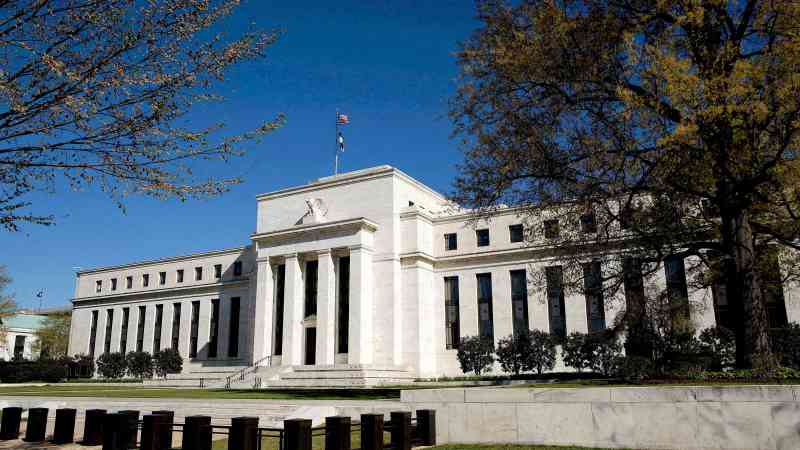Fed ‘ready to cut US interest rates next month’
Officials at the Federal Reserve last month were strongly inclined towards an interest rate cut at their September policy meeting and several of them would have even been willing to reduce borrowing costs immediately.
Minutes from the Fed’s open market committee meeting at the end of July, when the cost of borrowing was held in the 5.25 per cent to 5.5 per cent range, show the “vast majority” of ratesetters said “it would likely be appropriate to ease policy at the next meeting” if the economic data came in as expected.
The minutes also noted “many” Fed officials viewed the stance of rates to be restrictive and “a few participants” contended that, amid a continuing cooling in inflationary pressures, no change in rates would mean that monetary policy would increase the drag on economic activity.
The minutes said that while all Fed officials agreed with keeping rates steady in July, “several” policymakers said that progress on lowering inflation amid a rise in joblessness “had provided a plausible case for reducing the target range 25 basis points at this meeting or that they could have supported such a decision”.
The case for cutting rates rests on easing price pressures and getting inflation back to the central bank’s 2 per cent target amid increased anxiety about the state of the jobs market in the wake of recent data showing a rise in the unemployment rate. The Fed’s concerns about the jobs market will have been heightened by the Labor Department’s revised estimate on Wednesday that 818,000 fewer payroll jobs existed in March than previously reported. The change was part of the annual benchmark revision process. Analysts at Goldman Sachs said that they expected a cut of about 600,000 to the payrolls estimate over 12 months to April.
The speed of the jump in the jobless rate, which bottomed at 3.4 per cent early last year and has since climbed to 4.3 per cent as of last month, has added urgency to the debate over rate cuts and has prompted some analysts to say that a half-percentage-point reduction in borrowing costs should be considered next month.
The minutes noted that officials see the jobs market as having largely returned to where it was before the Covid-19 pandemic started, and described the labour market as “strong but not overheated.” Financial markets have been expecting the Fed’s September meeting to begin the reductions in the federal funds rate, with as much as a full percentage point worth of easing expected by the end of this year.
Traders are pricing in a 33 per cent probability of a 50 basis point cut next month, little changed from before the revised jobs data, and a 67.5 per cent chance of a 25 basis point reduction, according to the closely watched CME Group’s FedWatch tool.
“A deteriorating labour market will allow the Fed to highlight both sides of the dual mandate and investors should expect the Fed to prepare markets for a cut at the September meeting,” Jeffrey Roach, chief economist at LPL Financial, one of America’s biggest independent broker-dealer firms, said.
“A weaker than expected job market could pave the way for the Fed to cut by a half percentage point in September.”
Tom di Galoma, managing director and head of fixed income at Curvature Securities, a rival broker-dealer, said: “My general feeling is that the Fed probably wants to make a 50 basis point cut in September, rather than 25, just because it’s the first rate cut and you want to get the process going, and then 25 in November and 25 in December.”
The revised figures mean the US jobs market has been softening more than anticipated in a key election year, raising speculation about major interest rate cuts from the Fed this year.
A rate cut in September, coming less than two months before the presidential election, could bring some unwelcome political heat on the Fed, which seeks to avoid becoming involved in election-year politics.

Donald Trump, the former president, has argued that the Fed should not cut rates so close to an election. But Jerome Powell, the Fed’s chairman, has repeatedly underscored that the central bank would make its rate decisions based purely on economic data, without regard to the political calendar.Wall Street managed to hold on to gains after the updated jobs data and the Fed minutes.
By the close on Wednesday in New York, the broadly-based S&P 500 was up 0.42 per cent at 5,620.85 while the technology-heavy Nasdaq had risen 0.57 per cent to 17,918.99. The dollar fell against a number of major currencies, while the benchmark ten-year yield on US Treasuries dipped to 3.791 per cent, after earlier falling to a two-week low of 3.782 per cent. On the wider commodities market, spot gold prices eased 0.1 per cent to $2,508.40 an ounce, a day after hitting a record high of $2,511.30 an ounce, a rise of 3.4 per cent since the start of August.
Concerns about growth in the US economy outweighed worries about conflict in the Middle East disrupting supplies as Brent crude, the international benchmark, fell almost 2 per cent to $75.77, taking its monthly fall to almost 4.5 per cent.
“The market is going from pricing in a stronger economy to a potential hard landing, which is why oil prices are reluctant to move higher,” Phil Flynn, an analyst with Price Futures Group, said.Markets are likely to get an update of Powell’s views on Friday when he speaks at the Kansas City Fed’s annual research conference in Jackson Hole, Wyoming.




Post Comment